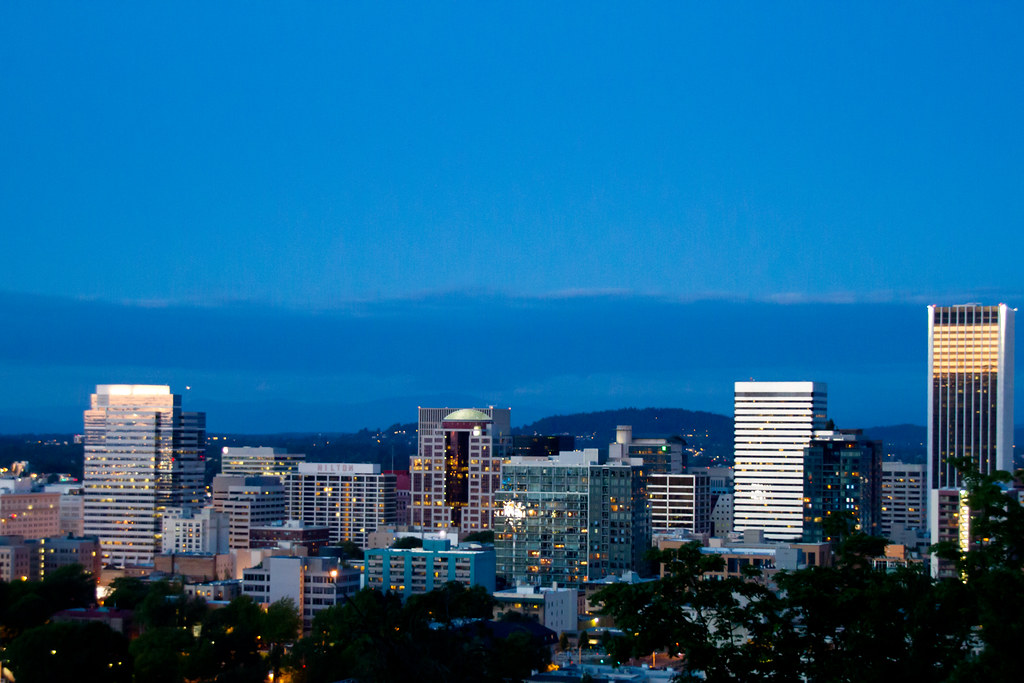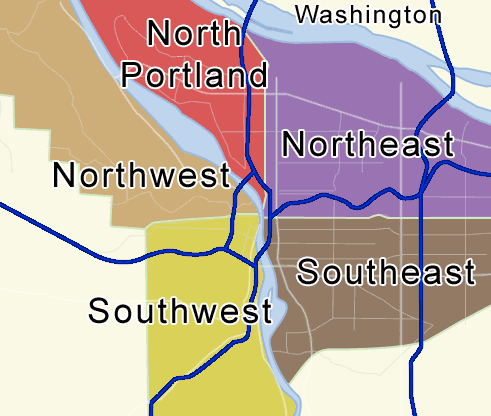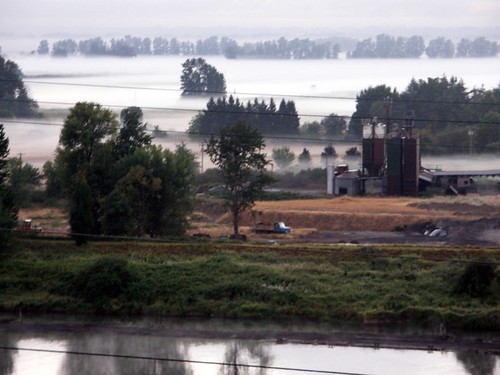Every once in awhile I’m honored to share content or even an entire guest post written by a loyal Twelve Mile Circle reader. We are very lucky today. Marc Alifanz contributes his expert knowledge of Geo-oddities in Portland, Oregon. Marc is an experienced blogger both in his professional and personal life and as he demonstrates below, has a keen interest in geographic features both magnificent and unusual. He invites the 12MC community to add any other Portland oddities that you may know about. Thank you Marc for this incredible post.
Take it away, Marc…

I’ve been living in Portland, Oregon for about five years, and since I’ve been reading Twelve Mile Circle I’ve occasionally had the thought that a post on my new home town would be an appropriate and interesting post for the site. Here’s a list of some of the geo-oddity or geo-historically interesting features of Portland that I’ve come up with.
Wilderness Parkland
Portland is reputed to have the largest wilderness park inside a city limits in the United States. Forest Park is a lot of old growth or second (but still very old) growth that covers 5,100 acres in the West Hills of Portland, with a vast array of hiking and biking trails.
Smallest Municipal Park
Portland also has the smallest municipal park in the world. Mill Ends Park has a diameter of 2 feet and is an officially recognized city park downtown along Naito Parkway, which runs along the Willamette River. I drive by it every day on my way home from work, and the shrubbery frequently changes, sometimes in very amusing ways.
Extinct Volcano
Portland is one of only three cities in the United States with an extinct volcano within its city limits. Most people here say it’s the only one, but Wikipedia knows better. Mt. Tabor on Portland’s east side is an extinct volcano and city park. Hiking through the park you can walk in and around the long extinct caldera, which is pretty awesome. Mt. Tabor Park also houses a good portion of Portland’s reservoir system, which is one of the only open air systems of its size remaining in the US. The history and drama of the reservoirs alone could fill a book.
Active Volcanoes

Four active or potentially active volcanoes can be seen from inside the Portland city limits, which has to be a record of some sort. This is fairly incredible when you think about it. On a clear day, from various points within the city limits, one can see Mount Hood, Mount Adams, Mount St. Helens, and a very distant but still visible Mount Rainier. We are lucky enough to be able to see all four from our house on a clear day. My wife and I often rate the weather by the number of volcanoes we can see at a time. (“Good morning hon, looks like a 3 mountain day today.”)
More Than Four “Quadrants”

Portland is split into quadrants, but that apparently wasn’t enough. All streets in Portland have a quadrant designation. The north-south boundary line is Burnside Street. The east-west boundary is the Willamette River. All addresses carry a NW, NE, SW, or SE designation…except…just north of downtown, the River turns toward the northwest. To keep the numbering system consistent on a north-south basis east of the river, the city planners carved out a “fifth quadrant,” which carries a plain old “North” designation. Also, there is arguably a sixth/seventh quadrant because addresses along Burnside Street, the north/south border are considered neither north nor south, and carry just an E or W designation. Also, unknown to me until writing this, there is a “hidden” quadrant in SW.
On the west side south of downtown, the RiverPlace, John’s Landing and South Waterfront Districts, which are all relatively new construction, lie in an area where addresses go higher from west to east toward the river. East-West addresses start with a leading zero. For example, this means 0246 SW California St. is different from 246 SW California St. While not technically a new quadrant (it still carries a SW designation), it is a unique deviation from the established numbering system.
Inspiring The Simpsons
The Simpsons: maybe not a geo-oddity per se, but a fun game for Simpsons nerds. On the west side of the river, starting with Burnside Street and moving north, all the streets start with subsequent alphabet letter…i.e. Burnside, NW Couch, Davis, Everett and so on up to NW Wilson Street. What everyone in town knows is that these streets serve as the names for various Simpsons characters, including, Burns (Burnside), Flanders, Lovejoy, and Quimby.
What many locals don’t realize is that there are several other hidden streets/cities around Portland that serve as Simpsons’ names. One of those is SW Terwilliger Blvd, which is the basis for Sideshow Bob’s last name, and also, the Montgomery Park building in NW Portland serves as Mr. Burns’ first name. The one I think very few people know about is N Van Houten Street, which inspires the last name of Bart’s friend, Millhouse. I’m guessing there may be others hidden around town I have yet to discover.
Beer
Also not a geo-oddity, but of possible interest is that Portland has the highest number of micro-breweries per capita of any city in the country. [editor’s note: 12MC heartily approves]
Coin Flipping

Portland was originally founded by Asa Lovejoy from Boston, Massachusetts and Francis W. Pettygrove of Portland, Maine. Each wanted to name the new town after their place of origin. They flipped a coin, and Portland won. It’s probably a good thing it worked out that way, because two Bostons of very large size would have created more confusion than big Portland, OR and littler Portland, ME do now.
Nearby Geo-oddity: Sauvie Island

This is one that is close to my heart, because I live just next to the only bridge providing access to Sauvie Island, which is unique in and of itself. The southern end of the island sits about a mile north of the Portland city limits. The south end sits in the Willamette River, and the part of the river that routes to the west of the island forms the Multnomah Channel. The Willamette River continues along the east side of the island where it empties into the Columbia River. The Multnomah Channel then empties into the Columbia some 15 miles further north by St. Helens, Oregon.
It’s a big island. Bigger than Manhattan. So big, in fact, that it constitutes the largest river island in North America, and the second largest freshwater island in the United States after Isle Royale in Lake Superior. The island is also steeped in history, dating back to 1792. Now it serves as an agricultural area (we buy all our produce there), a wildlife preserve, and has great sandy beaches along the Columbia on its northeastern shores. Although apparently safe enough for swimming, I don’t plan to go in given that it’s just downstream from about 50 Superfund sites (possibly the inspiration for Blinky on the Simpsons?).
Nearby Geo-oddity: Columbia River Gorge

Nuff said about this unbelievable and unique geographical formation, formed by the incredible Missoula Floods (which are also responsible for the extremely rich Willamette Valley soils), which houses some of the most amazing waterfalls and quasi-rain forests in the northwest including Multnomah Falls, the third tallest year round waterfall in the United States. Also, the Gorge is responsible for a large amount of Portland’s occasional snowfall, as it essentially acts as a wind funnel, shunting cold high desert air from the east in a westerly direction toward the Willamette Valley, and dropping the temperature just enough in Portland’s always rainy winter to make snow or ice. When I want to impress out of town visitors to Portland, this is where I take them.

Leave a Reply